当前位置:网站首页>Key value judgment in the cycle of TS type gymnastics, as keyword use
Key value judgment in the cycle of TS type gymnastics, as keyword use
2022-07-06 07:29:00 【Jioho_】
TS Type gymnastics And Key value judgment in the loop ,as Keyword use
Here are a few topics , Very representative , And these topics use a lot of keywords and TS grammar
- How to judge the key value in the loop of the object
- P in keyof as any extends P What does that mean?
- If you have to use & operator , How to merge before returning & 2 Content of edges
The selected questions above , In fact, the problem-solving routines are the same , Got it 3 After a question , These questions can be solved by setting templates
00003-medium-omit Topic realization
demand : Omit Will create an ellipsis K In the field T object .
This sum Pick It's like , It's just the opposite ,Pick Is to select the required fields , and Omit Exclude the specified field
- According to the known keywords , keyof Definitely , But how to exclude other keys ?
useneverTo make the key , You can exclude the value in this field
So the first question arises How to judge the key value in the loop of the object
First look at the answer :
type MyOmit<T, K extends keyof T> = {
[P in keyof T as P extends K ? never : P]: T[P]
}
K extends keyof T These grammars are not explained , and Pick equally , If you don't know, you can see the first article ,TS Pre knowledge of gymnastics
The point is P extends K ? never : P Judge P Whether this key belongs to K The scope of the , What belongs to is to be excluded , return nerver, If you don't belong to, you need to return to the current P, For keeping the current key
Seeing this leads to the second question P in keyof as any extends P What does that mean?
Add some parentheses to understand
[
(P in keyof T) as
(P extends K ? never : P)
]
With as Demarcation , Divide this code into 2 paragraph
P in keyof TTraversal means , That's easy to understand- as Here, let's consider it as Assertion
P extends K ? never : PHere is to judge the type
How to connect them
- P stay T Range loop
- P Get is T The key
- For this P We affirm for him by
P / never - If P The key of is K In the range of , We will assert the current P yes never( Abandon the original P Value ), So when the object loops never Will be ignored , So as to achieve Omit
00008-medium-readonly-2 Topic explanation
demand : This is readonly Of plus edition , Specify fields to readonly, If not specified, it will be regarded as all readonly
good heavens , Just finished learning Pick and Omit, It is also the specified field , It's easy to catch , use & Merge and you're done
Here is a demonstration of the error :
The wrong idea at that time was like this : Since it is the specified field readonly, Then I'll take it The original object and Merge the objects from the specified field loop , Loop object plus readonly, Let the following fields overwrite the previous , That won't achieve the effect
// Error model
type MyReadonly21<T, K extends keyof T = keyof T> = T & {
readonly [P in K]: T[P]
}
The result must be wrong , because & Operator calculates intersection , To put it simply, a piece of code is
type testReadonly = {
title: string; name: string } & {
readonly title: string; name: string }
// test Will report a mistake : The prompt is missing title Field
// Property 'title' is missing in type '{ name: string; }' but required in type '{ title: string; name: string; }'.
const test: testReadonly = {
name: '111'
}
According to the truth title The merged fields should also be read-only , But he became mandatory . intersection Fine products , hold readonly Understood as a title One of the fields additional The label of
The correct answer is as follows :
use Omit Pick out the required fields , And then with Pick Pick out readonly The object of , this 2 The correct answer is to merge objects
type MyReadonly2<T, K extends keyof T = keyof T> = {
[P in keyof Omit<T, K>]: T[P]
} & {
readonly [P in K]: T[P]
}
There are also complex schemes , Just pretend I can't use Omit , Using the routine just learned above can also solve this problem
type MyReadonly21<T, K extends keyof T = keyof T> = {
[P in keyof T as P extends K ? never : P]: T[P]
} & {
readonly [P in K]: T[P]
}
02595-medium-pickbytype Topic realization
This topic is exactly the same as the above routine !! It's also necessary to decide what to do when cycling key To keep
The difference is to filter according to the corresponding types of different fields , That is to say, before [P in keyof T as P extends U], Change it into [P in keyof K as T[P] extends U ? nerver : P]
Be careful T[P] extends U Writing ! The change of such a parameter , The rest should be taken P Or take P, The never still never, The problem is solved
02757-medium-partialbykeys Topic explanation
demand : Specify fields to set optional , If it is not specified, it will be regarded as all selected
It is this problem , The questions that come out 3: If you have to use & operator , How to merge before returning & 2 Content of edges
See this problem , Is it right? readonly2 Our needs are the same , It's nothing more than putting readonly Switch to ?
The code was written in a snap , Then look at the test cases None of them
type PartialByKeys<T, K extends keyof T = keyof T> = {
[P in keyof T as P extends K ? never : P]: T[P]
} & {
[P in K]?: T[P]
}
But watch the field carefully , What is required is required , There are ?. Except that the case gives a complete object , And mine is a {} & {} Cross calculated , There is no difference between others
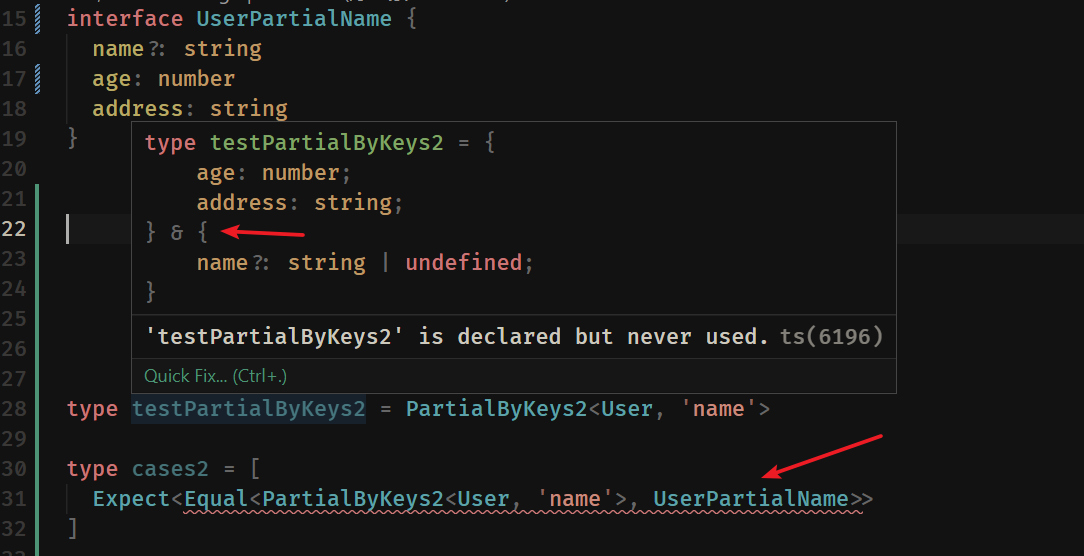
Then I studied the test cases carefully , Look for the 02757-partialbykeys The test case of this question , It's using Equal Tool class
type cases = [
Expect<Equal<PartialByKeys<User, 'name'>, UserPartialName>>,
Expect<Equal<PartialByKeys<User, 'name' | 'unknown'>, UserPartialName>>,
Expect<Equal<PartialByKeys<User, 'name' | 'age'>, UserPartialNameAndAge>>,
Expect<Equal<PartialByKeys<User>, Partial<User>>>
]
and 08-readonl2 Test cases for , It's using Alike :
type cases = [Expect<Alike<MyReadonly21<Todo1>, Readonly<Todo1>>>]
good heavens .. In this case , readonl2 It's not a complete standard answer , At most 98 branch ?
It is also very easy to solve this problem , We just have to take 2 Just merge them , As for how to merge ?
Another trick —— use Pick, because Pick Can bring out all the fields , Then merge into a new object , We only need to put all our fields in and extract them once , Can merge together
type Clone<T> = Pick<T, keyof T>
type PartialByKeys<T, K extends keyof T = keyof T> = Clone<
{
[P in keyof T as P extends K ? never : P]: T[P]
} & {
[P in K]?: T[P]
}
>
Come here , The regular example has passed , And one more PartialByKeys<User, 'name' | 'unknown'> Reporting errors
Because the second field passed in here may not be User Inside , such as unknown It's not there User Of key in , And we K extends keyof T = keyof T This limits the entry of parameters , So we can only remove the restrictions , Change to the following
type PartialByKeys2<T, K = keyof T> = Clone<
{
[P in keyof T as P extends K ? never : P]: T[P]
} & {
[P in K]?: T[P]
}
>
After removing the restrictions , added 2 A new error report
- K The error of Type ‘K’ is not assignable to type ‘string | number | symbol’.
T[P]The error of Type ‘P’ cannot be used to index type ‘T’.
Because there is really no limit k The type of , and in What circulates is unio( Joint type ) The variable of T[P] because K It doesn't have to be T The key inside ,T[‘unknown’] It certainly doesn't exist , That's why I made a mistake
So when K In the cycle , Or use it back The routine just learned , Determine the key value in the loop [P in K as P extends keyof T ? P : never]
T[P] The solution to the problem is to judge first P Is in T Only read within the scope of T[P] Just OK 了
The complete correct answer is as follows :
type PartialByKeys2<T, K = keyof T> = Clone<
{
[P in keyof T as P extends K ? never : P]: T[P]
} & {
[P in K as P extends keyof T ? P : never]?: P extends keyof T ? T[P] : never
}
>
Last
Let's answer a few questions
- How to judge the key value in the loop of the object
- use
askeyword ,as Followed by conditional statements , If false, Then return to never You can exclude a key value
- use
- P in keyof as any extends P ? never : P What does that mean?
- P in keyof It's a group.
- extends P ? never : P It's a group.
- Last 2 The value of the group is as link , The key that forms the current loop
- If you have to use & operator , How to merge before returning & 2 Content of edges
- & Symbols are a process of cross merging , The merged objects are There is no difference in the function of constraint data
- But the data after cross operation and single type are used Strictly equal The result of comparison is false
- Finally, it can be based on Pick Tools , Encapsulates a Clone Tools , hold
{} & {}Merge into one{}
边栏推荐
- Methods for JS object to obtain attributes (. And [] methods)
- GET/POST/PUT/PATCH/DELETE含义
- [window] when the Microsoft Store is deleted locally, how to reinstall it in three steps
- chrome查看页面fps
- 【mysql学习笔记29】触发器
- Sélectionnez toutes les lignes avec un symbole dans Word et changez - les en titre
- Simulation of Teman green interferometer based on MATLAB
- Games101 Lesson 7 shading 1 Notes
- Typescript function definition
- Markdown 中设置图片图注
猜你喜欢

杰理之AD 系列 MIDI 功能说明【篇】
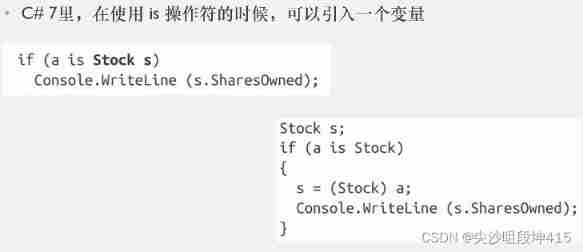
C - Inheritance - polymorphism - virtual function member (lower)
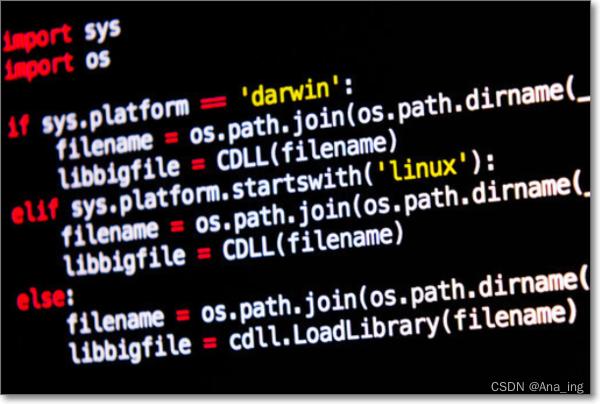
Twelve rules for naming variables
![[computer skills]](/img/30/2a4506adf72eb4cb188dd64cce417d.jpg)
[computer skills]

Crawling exercise: Notice of crawling Henan Agricultural University

1091: two or three things in childhood (multi instance test)

学go之路(一)go的基本介绍到第一个helloworld
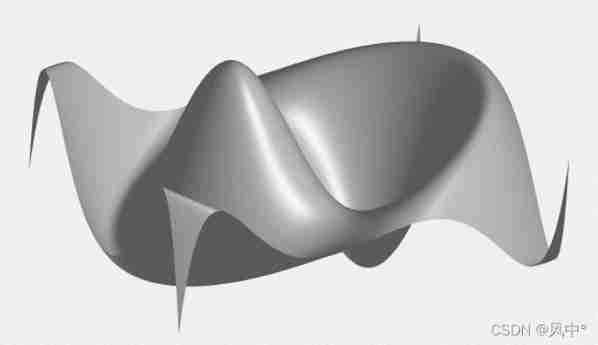
Simulation of holographic interferogram and phase reconstruction of Fourier transform based on MATLAB
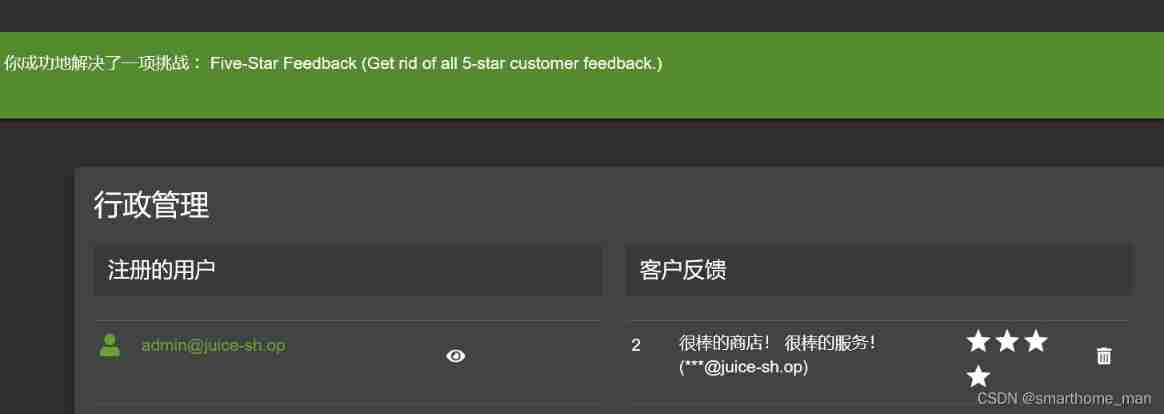
Solution to the problem of breakthrough in OWASP juice shop shooting range

Games101 Lesson 7 shading 1 Notes
随机推荐
The best way to learn SEO: search engine
Solution to the problem of breakthrough in OWASP juice shop shooting range
How to delete all the words before or after a symbol in word
Sharing of source code anti disclosure scheme under burning scenario
The differences and advantages and disadvantages between cookies, seeion and token
Simulation of Teman green interferometer based on MATLAB
Leecode-c language implementation -15 Sum of three ----- ideas to be improved
Week6 weekly report
【mysql学习笔记30】锁(非教程)
软件测试界的三无简历,企业拿什么来招聘你,石沉大海的简历
On the world of NDK (2)
Three no resumes in the software testing industry. What does the enterprise use to recruit you? Shichendahai's resume
Excel的相关操作
[JDBC] quick start tutorial
CF1036C Classy Numbers 题解
Typescript indexable type
Oracle column to row -- a field is converted to multiple rows according to the specified separator
TS 体操 &(交叉运算) 和 接口的继承的区别
Select all the lines with a symbol in word and change them to titles
学go之路(二)基本类型及变量、常量



